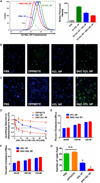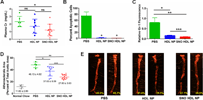Nitric Oxide-Delivering High-Density Lipoprotein-like Nanoparticles as a Biomimetic Nanotherapy for Vascular Diseases
- PMID: 29385802
- PMCID: PMC8495904
- DOI: 10.1021/acsami.7b18525
Nitric Oxide-Delivering High-Density Lipoprotein-like Nanoparticles as a Biomimetic Nanotherapy for Vascular Diseases
Abstract
Disorders of blood vessels cause a range of severe health problems. As a powerful vasodilator and cellular second messenger, nitric oxide (NO) is known to have beneficial vascular functions. However, NO typically has a short half-life and is not specifically targeted. On the other hand, high-density lipoproteins (HDLs) are targeted natural nanoparticles (NPs) that transport cholesterol in the systemic circulation and whose protective effects in vascular homeostasis overlap with those of NO. Evolving the AuNP-templated HDL-like nanoparticles (HDL NPs), a platform of bioinspired HDL, we set up a targeted biomimetic nanotherapy for vascular disease that combines the functions of NO and HDL. A synthetic S-nitrosylated (SNO) phospholipid (1,2-dipalmitoyl-sn-glycero-3-phosphonitrosothioethanol) was synthesized and assembled with S-containing phospholipids and the principal protein of HDL, apolipoprotein A-I, to construct NO-delivering HDL-like particles (SNO HDL NPs). SNO HDL NPs self-assemble under mild conditions similar to natural processes, avoiding the complex postassembly modification needed for most synthetic NO-release nanoparticles. In vitro data demonstrate that the SNO HDL NPs merge the functional properties of NO and HDL into a targeted nanocarrier. Also, SNO HDL NPs were demonstrated to reduce ischemia/reperfusion injury in vivo in a mouse kidney transplant model and atherosclerotic plaque burden in a mouse model of atherosclerosis. Thus, the synthesis of SNO HDL NPs provides not only a bioinspired nanotherapy for vascular disease but also a foundation to construct diversified multifunctional platforms based on HDL NPs in the future.
Keywords: S-nitrosylation; biomimetic; high-density lipoprotein-like nanoparticles; nanotherapy; nitric oxide-delivering; vascular disease.
Figures






References
-
- Roger VL; Go AS; Lloyd-Jones DM; Adams RJ; Berry JD; Brown TM; Camethon MR; Dai S; de Simone G; Ford ES; Fox CS; Fullerton HJ; Gillespie C; Greenlund KJ; Hailpem SM; Heit JA; Ho PM; Howard VJ; Kissela BM; Kittner SJ; Lackland DT; Lichtman JH; Lisabeth LD; Makuc DM; Marcus GM; Marelli A; Matchar DB; McDermott MM; Meigs JB; Moy CS; Mozaffarian D; Mussolino ME; Nichol G; Paynter NP; Rosamond WD; Sorlie PD; Stafford RS; Turan TN; Turner MB; Wong ND; Wylie-Rosett J; American Heart Assoc Stat, C.; Stroke Stat, S., Heart Disease and Stroke Statistics-2011 Update A Report From the American Heart Association. Circulation 2011, 123 (4), E18–E209. - PMC - PubMed
-
- Schulz R; Kelm M; Heusch G, Nitric oxide in myocardial ischemia/reperfusion injury. Cardiovascular research 2004, 61 (3), 402–413. - PubMed
-
- Giraldez RR; Panda A; Xia Y; Sanders SP; Zweier JL, Decreased nitric-oxide synthase activity causes impaired endothelium-dependent relaxation in the postischemic heart. Journal of Biological Chemistry 1997, 272 (34), 21420–21426. - PubMed
-
- Napoli C; de Nigris F; Williams-Ignarro S; Pignalosa O; Sica V; Ignarro LJ, Nitric oxide and atherosclerosis: an update. Nitric oxide 2006, 15 (4), 265–279. - PubMed
MeSH terms
Substances
Grants and funding
LinkOut - more resources
Full Text Sources
Other Literature Sources
Research Materials

